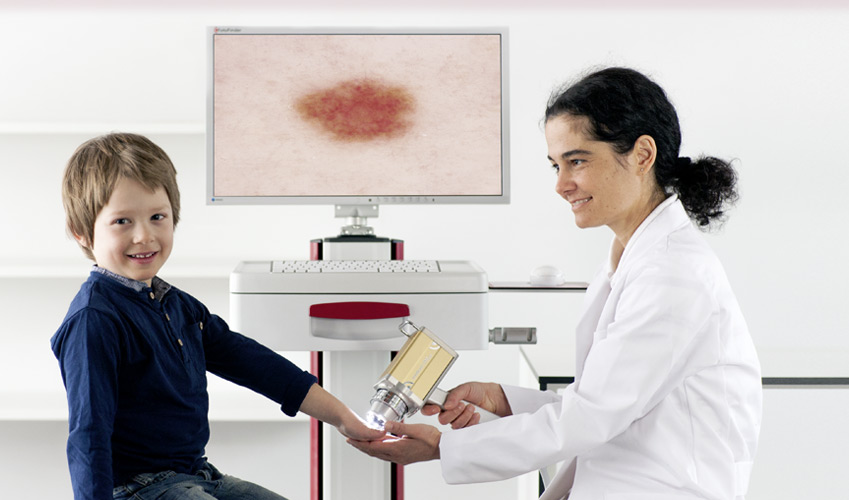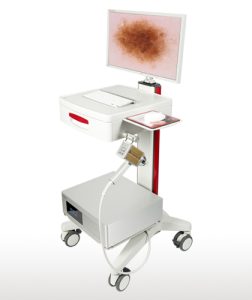SERVICES
- Allergy Screening
- Chemical Peels
- Dermapen
- Facial Skin Analysis
- FreshEyes
- Hyperhidrosis (Excessive Sweating)
- Hair Loss Treatment
- Laser Clinic
- Liquid Facelift
- Keloid Treatments
- Medical Facials
- Medical Treatments
- Mole Mapping
- Photodynamic Therapy (PDT)
- Skincare Advice
- Pigmentation Treatment
- Surgical Procedures
- Ultraviolet Phototherapy
USEFUL LINKS

If a mole changes its appearance, or if a new mark appears on the skin that looks like a mole, this may represent malignant melanoma and should be reported to your doctor for urgent assessment. The surgical removal of malignant melanoma at an early stage in its development can prevent its spread and cure the condition. However, almost everyone has moles and some people have quite a lot. It can therefore sometimes be difficult to know whether a mole has changed or whether a mark on your skin is new. This is a particular problem for skin sites that are hard to keep an eye on, for instance your back. We therefore provide a state of the art computer-assisted mole mapping and digital photo-dermoscopy surveillance service. This is particularly useful for people who are known to have an increased risk of the development of malignant melanoma.
 Who should consider having their moles mapped?
Who should consider having their moles mapped?
People who are at increased risk of the development of skin cancer. This includes those with:
1. Large number of moles
2. Moles that have an unusual appearance (atypical moles)
3. A family history of skin cancer
4. A personal history of skin cancer
5. Pale skin that easily burns in the sun
6. Episodes of previous severe sun burn
7. Exposure to significant amounts of sunlight like working or living abroad, outdoor work
8. A suppressed immune system.
What does it involve?
1. The doctor will record your medical history to identify any risk factors for skin cancer
2. Standardised whole body digital photographs are taken and stored on our secure computer
3. Your skin is examined by the dermatologist to identify any suspicious lesions
4. Unusual appearing but harmless moles are photographed using a close-up technique called digital photo-dermoscopy
5. You will immediately be advised if any of your moles have the features of melanoma. We will usually offer to remove these on the same day.
6. In most cases, no melanoma will be found. Under these circumstances, we will usually offer to repeat the screening in 6 to 12 months, or sooner if you notice any changes in the meantime. At these follow-up screenings, your previously stored photographs are used as a baseline to detect any new or changing lesions.
What are the advantages?
1. Malignant melanoma can be detected at an early stage when treatment is most effective
2. Your skin will be examined for malignant melanoma by a specialist dermatologist
3. One-stop screening and surgical removal is offered for those with malignant melanoma
4. Your whole body photographs and digital photo-dermoscopy images are retained for future comparisons
5. Unnecessary removal of harmless moles can be prevented.
Patient Testimonials
EXCELLENTTrustindex verifies that the original source of the review is Google. From my first visit with Dr Jhetam I knew I would go back. He is compassionate , friendly and has an interaction which made you feel comfortable. This is very important in any doctor because our relationship with our doctor is very intimate.Trustindex verifies that the original source of the review is Google. Dr Jhetman is truly one of a kind. Anyone who is fortunate enough to be in his care can so grateful. Academic, informative and reassuring. It’s hard to find a doctor who has this combination of skills these days. He dealt with my Melonoma concerns with swift and professional care. And his staff are equally as competent and caring. I cannot commend Dr Jhetman and his staff enough on true patient care. Thank you!Trustindex verifies that the original source of the review is Google. I was absolutely satisfied with my experience with Dr Jhetham & his winning team. Keep up the good work.Trustindex verifies that the original source of the review is Google. Best skin doctor..Dr Jetham prescribed the best products that have brought so much of a glow to my skin..being a transplant patient and so much happening to my skin just 4 visits to him and my face is back to it's radiance ..I hightly reccomend Dr Jetham ...you won't go wrong..Trustindex verifies that the original source of the review is Google. Dr. Imraan Jhetam and his team provided exceptional care, showcasing professionalism and compassion in every interaction. Dr. Jhetam took the time to thoroughly explain everything, addressing each of my concerns with empathy and understanding. My experience with him was truly wonderful, and I highly appreciate his dedication to patient care.Verified by TrustindexTrustindex verified badge is the Universal Symbol of Trust. Only the greatest companies can get the verified badge who has a review score above 4.5, based on customer reviews over the past 12 months. Read more



